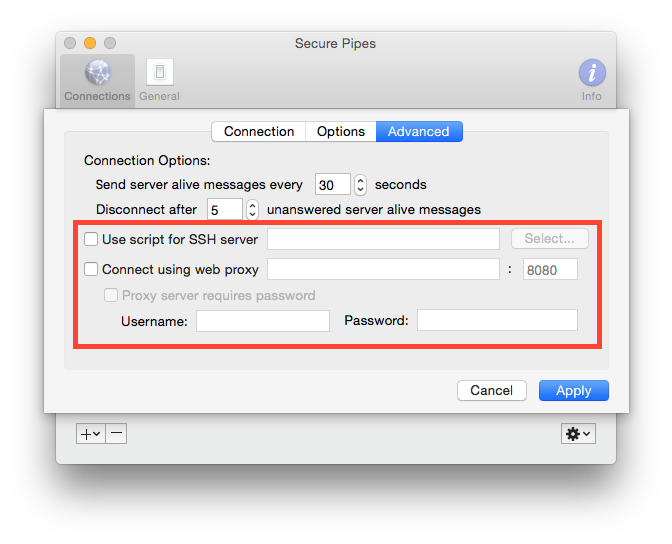Version v0.85

Secure Pipes v0.85 is Released!
It's been a while since I added any features to Secure Pipes, so I recently took the time to add two that were requested by some users. They are fairly straightforward to use, but I'll give them some words anyway.
HTTP Proxy Support
In some very restrictive network environments (mostly in big corporations), users are only allowed to access the internet by HTTP proxy. I've added a feature in the "Advanced" tab of each connection type that will allow you to use an HTTP proxy to make the SSH connection to your SSH server. Note not all HTTP proxies support this, so you'll have to check with your network admin. If your proxy requires a username and password, there are fields for this as well. Note that just like the SSH password, the HTTP proxy password is stored in the OS X keychain. I've only tested this with squid as a proxy server. I've used some others in the past, but that was the quickest (and cheapest) I could find that also supports authentication (which the user required). This implementation uses a modified version of corkscrew to open the SSH connection using SSH's ProxyCommand feature.
SSH Hostname from Script
In a somewhat unique request, I had a user who runs virtual machines on his Mac using Parallels. Since the virtual IP address of the machines change, he wanted a dynamic way to get the IP address for a connection. This feature runs a shell script and the output of which is expected to be the hostname or IP address of the connection. You can also type in arguments to the script, and Secure Pipes will also pass you a CONNECTION_NAME environment variable containing the connection name if that might be useful.
I'm currently working on further implementation of "Managed Connections" that will allow you to remotely control and monitor connections. This is part of the Free Proxies link on the site. Unfortunately, I haven't had much time to work on this lately, but hope to get back into it in the coming weeks.
Tim